Andhra cuisine, hailing from southeastern India, is a celebration of robust flavors and aromatic spices. Known for its fiery taste, this culinary tradition boasts a variety of dishes featuring tangy chutneys and rice-based specialties. Essential ingredients like coconut and a spectrum of vibrant chilies contribute to the unique taste profile. The influence of coastal flavors and the Telugu community adds a distinctive charm to the culinary offerings, creating a gastronomic experience that is bold, flavorful, and flamboyantly spicy.
Andhra Biryani
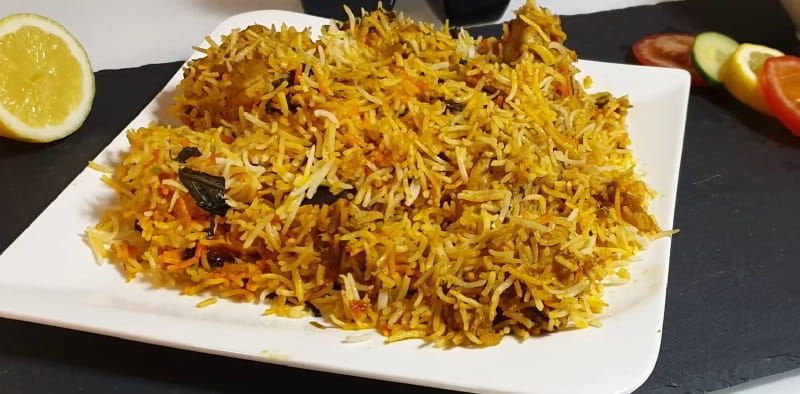
Andhra cuisine is known for its rich and flavorful dishes, and one of the most popular dishes is the Andhra Biryani. This delicious rice dish is made with aromatic basmati rice, tender pieces of meat (usually chicken or mutton), and a blend of spices that give it a unique and distinct taste. The Andhra Biryani is known for its spiciness, with the use of fiery red chillies and other spices like cinnamon, cardamom, and cloves. The meat is marinated in a mixture of yogurt and spices, which helps in tenderizing the meat and infusing it with flavors. The rice is cooked separately and then layered with the marinated meat, fried onions, and mint leaves. The dish is then cooked on a low flame, allowing the flavors to blend together and the meat to become tender and juicy. The Andhra Biryani is usually served with raita, a yogurt-based side dish, and a spicy curry. The combination of the flavorful biryani with the cool and refreshing raita creates a perfect balance of flavors. This dish is loved by people who enjoy spicy and aromatic food and is a must-try for anyone visiting Andhra Pradesh.
Vada
-1702597440.jpg)
Vada holds a cherished place in Andhra cuisine as a popular and flavorful dish. This delectable treat is a deep-fried fritter crafted from a batter featuring urad dal (black gram), onions, green chilies, ginger, and an array of spices. To prepare the batter, urad dal is soaked for several hours and then ground to a smooth consistency. The addition of chopped onions, green chilies, ginger, and spices elevates the overall flavor profile. The shaped vada, resembling a round disc or doughnut, is deep-fried until achieving a golden brown, crispy texture. Served piping hot, Andhra-style vada is enjoyed as both a snack and a breakfast item. It can be savored on its own or paired with accompaniments like coconut chutney, sambar (a lentil-based soup), or curd (yogurt). What sets Andhra-style vada apart is its unique taste and texture—crispy on the outside and soft and fluffy on the inside. The incorporation of spices, along with the addition of onions and chilies, imparts a delicious and slightly spicy flavor. Universally loved and considered a household staple, vada adds its flavorful touch to Andhra households and restaurants alike, appealing to taste buds of all ages.
Dosa
-1705500307.jpg)
Dosa, a quintessential South Indian delight, is a thin, crepe-like pancake made from a fermented batter of rice and urad dal (black gram). This iconic dish has transcended regional borders to become a beloved part of global cuisine. The preparation involves soaking and blending rice and urad dal and fermenting the mixture overnight, resulting in a light, airy batter. When ladled onto a hot griddle, the batter transforms into a golden, lacy dosa, thin at the edges and slightly thicker at the center. The versatile dosa comes in various forms, from the classic plain dosa to a myriad of stuffed variations like masala dosa. Served with an array of accompaniments such as coconut chutney and tangy sambar, dosa offers a harmonious balance of crispiness and softness, with a distinct tang from the fermentation process. Whether enjoyed for breakfast or as a savory snack, dosa stands as a symbol of South Indian culinary finesse, enticing palates with its delightful texture and flavor.
Dal (Tomato Pappu)
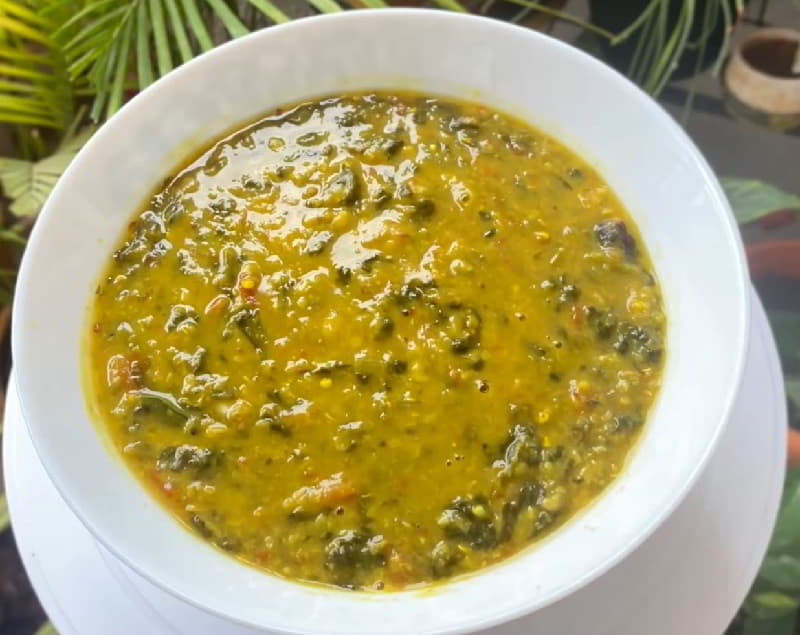
Andhra cuisine is renowned for its rich flavors and spicy dishes, and one of the most popular dishes is the Dal. This dish has several variations made from lentils like toor dal, masoor dal, and moong dal, which are all cooked to perfection with a blend of aromatic spices. One of the most popular dal dishes in Andhra cuisine is Tomato Pappu. Made with toor dal (split pigeon peas) and a vibrant medley of tomatoes, onions, and green chilies, it encapsulates the essence of traditional Indian cuisine. The preparation involves cooking toor dal until it achieves a velvety consistency, complemented by tempering of mustard seeds, cumin, asafoetida, and curry leaves. The addition of tomatoes imparts a tangy sweetness, harmonizing with the earthy lentils. A blend of turmeric and red chili powder provides a warm and aromatic undertone, creating a balanced and flavorful profile. Garnished with fresh coriander leaves, this dish is often served alongside steamed rice or bread, making Tomato Pappu a wholesome, nutritious, and cherished culinary experience.
Papadam
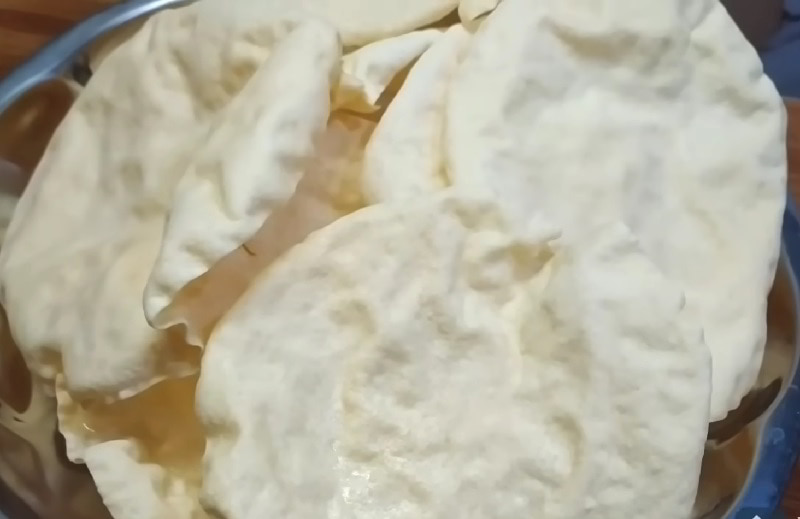
Papadam, also known as appalam, holds a special place in Andhra cuisine as a beloved dish. This crispy, thin, disc-shaped snack is crafted from lentil or rice flour, serving as a delightful accompaniment to meals, introducing a satisfying crunch to the dining experience. To create papadams, lentils or rice are ground into fine flour, and blended with spices like cumin, black pepper, and salt. The resulting dough is kneaded with water, rolled into thin circles, and then sun-dried, deep-fried, or roasted until achieving a crispy, golden-brown perfection. Enjoyed in various ways, papadams can be relished plain with a sprinkle of salt or paired with an array of chutneys and pickles. They also serve as a versatile base for chaats, adorned with a medley of spicy and tangy toppings like onions, tomatoes, and chutneys. Beyond their delicious taste, papadams offer several health benefits. Low in calories and fat, they make for a guilt-free snack rich in protein and dietary fiber, aiding digestion and promoting a sense of fullness. In Andhra cuisine, papadams are a cherished and versatile dish, elevating the appeal of every meal with their delectable crunch and distinctive flavors—a must-try for any food enthusiast.
Idli
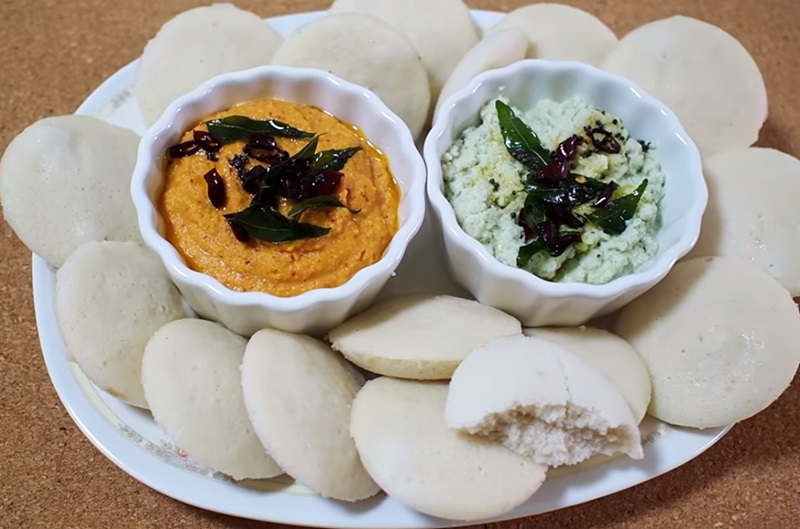
Idli, a renowned dish in Andhra cuisine, has garnered global acclaim for its simplicity and exquisite taste. This traditional South Indian breakfast staple is crafted from a fermented batter comprising rice and urad dal. The batter is meticulously prepared by soaking and grinding rice and lentils separately to achieve a smooth consistency. Left to ferment overnight, this process imparts idlis with a fluffy texture and a subtle tanginess. For idli preparation, the batter is poured into molds and steamed until it transforms into soft, spongy, round-shaped cakes. Light on the stomach and easily digestible, idlis are often served with an array of chutneys like coconut, tomato, or peanut, alongside sambar, a spicy lentil soup. Offering a healthy and nutritious option, idlis are low in fat, cholesterol-free, and rich in carbohydrates and proteins. Their gluten-free nature caters to individuals with gluten intolerance. With a neutral taste, idlis pair seamlessly with various sides and condiments, making them versatile and enjoyable for individuals of all ages. In essence, the idli dish in Andhra cuisine epitomizes a perfect fusion of simplicity, taste, and healthiness, earning its status as a beloved breakfast item not only in Andhra but also throughout India and beyond.
Andhra Thali
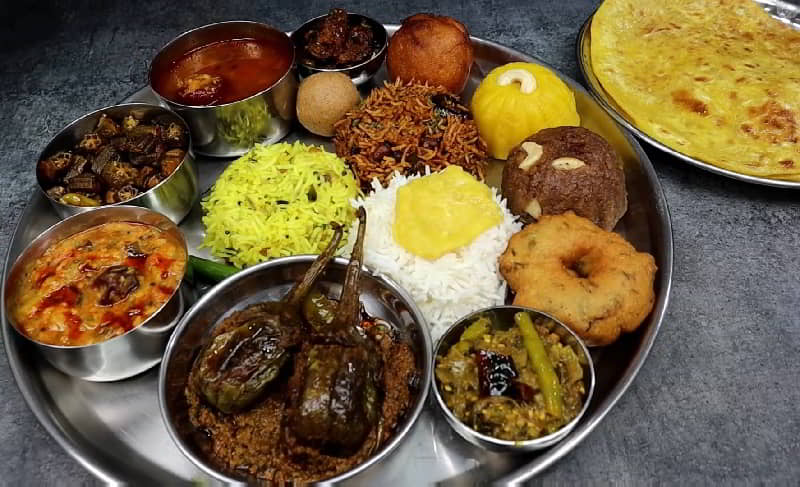
Andhra cuisine is known for its spicy and flavorful dishes, and the Andhra Thali is no exception. This traditional meal consists of a variety of dishes served on a large platter, providing a wholesome and satisfying experience. The Andhra Thali typically includes a main course of rice, along with a variety of curries and side dishes. Some popular options include spicy chicken curry, tangy fish curry, and flavorful vegetable stir-fries. These dishes are often accompanied by dal, a lentil-based soup, and sambar, a spicy vegetable soup. In addition to the curries, the Thali also includes different types of chutneys and pickles, which add a burst of tanginess and enhance the overall flavors. These condiments are made from a wide range of ingredients, such as tamarind, coconut, and various spices. To complete the Thali, a generous serving of yogurt is served, which helps balance the spiciness of the other dishes. And for those with a sweet tooth, a traditional dessert like payasam or kesari is served to provide a perfect ending to the meal. Overall, the Andhra Thali is a delightful assortment of dishes that showcases the rich and diverse flavors of Andhra cuisine. It is a true feast for the senses and a must-try for anyone looking to experience the authentic taste of Andhra Pradesh.
Sambar
-1705564408.jpg)
Sambar is a popular and flavorful dish in Andhra cuisine, originating from the southern region of India. It is a lentil-based vegetable stew that is made using a unique blend of spices and tamarind extract. The dish is known for its rich and tangy taste, making it a favorite among locals and tourists alike. To prepare Sambar, a variety of vegetables such as drumsticks, carrots, potatoes, and brinjals are cooked along with lentils. The lentils are usually toor dal or pigeon peas, which add a creamy texture to the dish. A special Sambar masala is made by grinding together spices like coriander seeds, cumin seeds, fenugreek seeds, red chili powder, turmeric powder, and asafoetida. This masala is then added to the cooked lentils and vegetables, along with tamarind extract, giving it a tangy flavor. Sambar is often served with steamed rice or idli, a popular South Indian breakfast item. The combination of the lentils, vegetables, and spices creates a delightful and aromatic dish that is loved by people of all ages. Whether enjoyed as a main course or a side dish, Andhra Sambar never fails to satisfy the taste buds with its rich and comforting flavors.
Upma
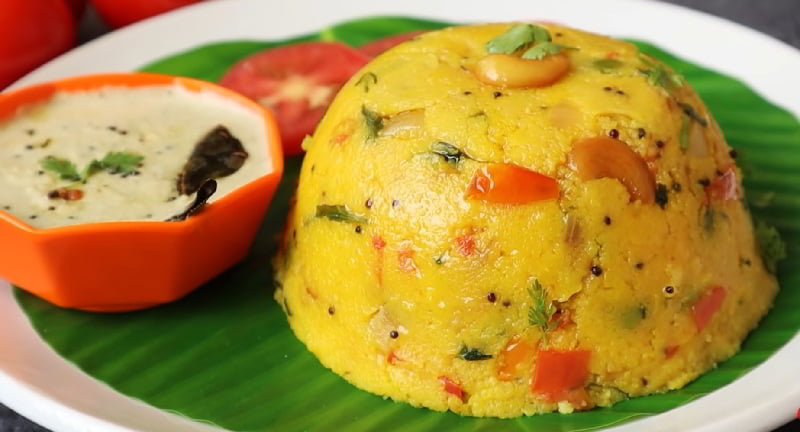
Andhra cuisine is known for its spicy and flavorful dishes, and one such popular dish is Upma. Upma is a savory breakfast dish made with semolina and a variety of vegetables. It is a quick and easy dish to prepare, making it a popular choice for breakfast or brunch. To make Andhra-style Upma, the semolina is first roasted until golden brown, which gives it a nutty flavor. Then, it is cooked with chopped onions, green chilies, ginger, and curry leaves. A medley of vegetables like carrots, peas, and beans is added to the mix, along with some turmeric for color. It is then garnished with fresh coriander leaves and served hot. Upma can be enjoyed on its own or with a side of coconut chutney or tomato chutney. With its combination of textures and flavors, Andhra-style Upma is a delicious and satisfying dish that is enjoyed by people of all ages. Whether for breakfast or as a light meal, it is a staple in Andhra cuisine and a popular choice for its simplicity and taste.
Pootharekulu
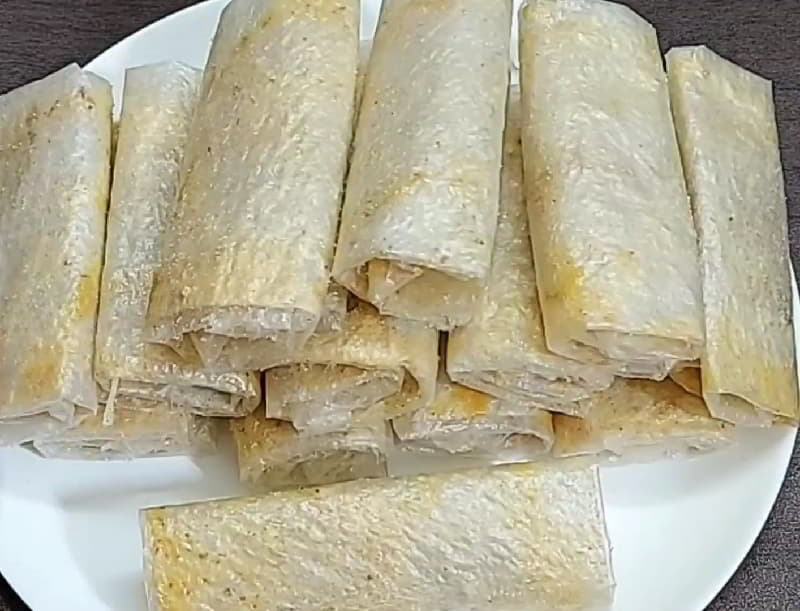
Pootharekulu, a popular confection originating from the Andhra Pradesh state in southeastern India, is a revered sweet synonymous with festivals, religious celebrations, and weddings. Comprising a delicate rice starch layer reminiscent of paper, this sweet encases a delectable filling of sugar, dry fruits, and nuts. The key ingredient is a unique rice batter known as jaya biyyam, where 'biyyam' signifies rice, harmoniously blended with powdered sugar and ghee (clarified butter). Crafting the edible film involves a meticulous process, commencing with the preparation of a heated pot with a hole for suitability. Over three days, the pot undergoes alternating heating and smoothing with a cloth soaked in oil. The coarse rice is ground for nearly two hours, resulting in a batter that, when diluted, is used to create a thin film. This film, formed instantly on the pot with a flame beneath, is then skillfully enveloped with sugar and/or jaggery before being luxuriously coated with ghee.
Puran Poli
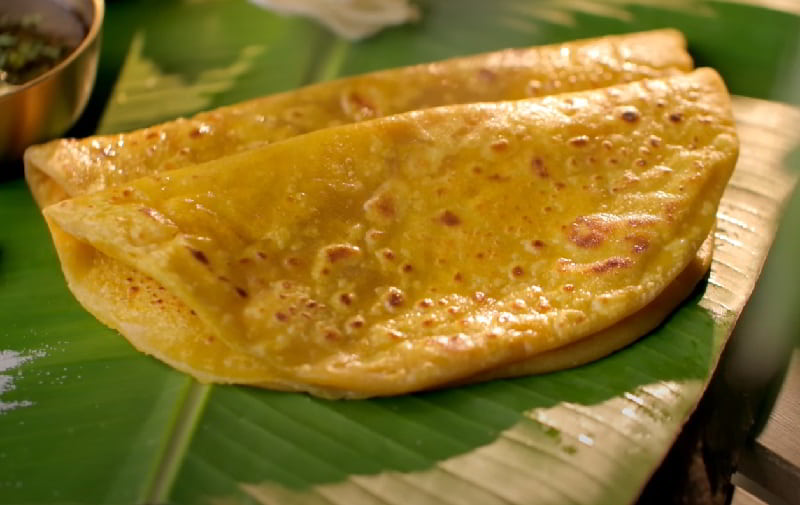
Puran poli is a popular and delicious dish in the Andhra cuisine. It is a sweet flatbread made with a filling of lentils, jaggery (a type of unrefined cane sugar), and aromatic spices. To prepare puran poli, a dough is made using wheat flour, water, and a pinch of salt. The filling is made by cooking chana dal (split Bengal gram lentils) until soft and then combining it with jaggery, ghee (clarified butter), cardamom powder, and nutmeg powder. This mixture is then mashed and rolled into small balls. The dough is rolled out into small circles, and a ball of the puran filling is placed in the center. The dough is then carefully sealed around the filling to form a stuffed bread. The stuffed bread is then rolled out into a larger circle and cooked on a hot griddle with ghee until it turns golden brown and crispy. Puran poli is typically served hot with a dollop of ghee on top. It is a popular dish during festivals and special occasions, loved for its rich and sweet flavors. The combination of the soft and sweet filling with the crispy outer layer makes puran poli a delightful treat for the taste buds.
Rasam
-1705473002.jpg)
Rasam is a renowned and flavorsome dish in Andhra cuisine. This tangy and spicy soup-like preparation is a culinary delight, often served as part of a meal or enjoyed independently. The distinctive taste of Andhra Rasam is achieved through a harmonious blend of various ingredients and spices. Key components in making Andhra Rasam include tamarind, tomatoes, lentils, and a medley of spices such as black pepper, cumin, coriander, and dried red chilies. These ingredients are skillfully cooked together with water to form a flavorful broth, with the lentils imparting a pleasing thickness to the Rasam. The finishing touch involves tempering, wherein ghee or oil is heated and mustard seeds, cumin seeds, curry leaves, and dried red chilies are added. This tempering is then poured over the prepared Rasam, elevating both its aroma and taste. Typically served hot, Andhra Rasam pairs excellently with steamed rice or can be relished as a light soup. Beyond its deliciousness, Andhra Rasam is recognized for its digestive properties, often consumed to aid digestion. The amalgamation of tangy, spicy, and aromatic flavors positions Andhra Rasam as a treasured dish in Andhra cuisine.
Ragi Mudde
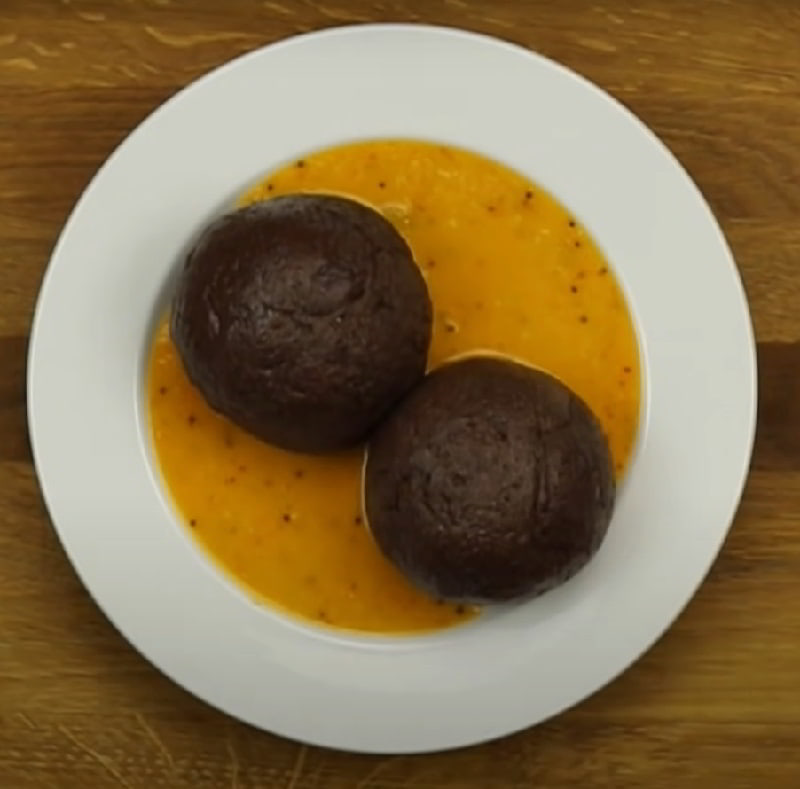
Ragi mudde, a traditional dish that finds its roots in the state of Andhra Pradesh in South India, is a simple yet nutritious culinary creation made from finger millet (ragi) flour and water. Ragi, known for its gluten-free nature, is abundant in fiber, protein, and essential minerals, making it a highly regarded choice for those seeking a wholesome and health-conscious meal. In the process of preparing ragi mudde, the ragi flour undergoes an initial roasting until it emits a nutty aroma. It is then combined with water and cooked over low heat, with a continuous stirring technique employed to prevent the formation of lumps. The mixture is cooked until it attains a thickened, smooth, dough-like consistency. The resulting dough is shaped into small balls or dumplings. Traditionally accompanied by an array of spicy curries or gravies, such as sambar or chicken curry, ragi mudde is relished by rolling the portions into small morsels and dipping them into the accompanying curry. This dish not only provides a filling and satisfying gastronomic experience but also stands as an excellent source of energy and nutrients. In numerous households in Andhra Pradesh, especially in rural areas, ragi mudde holds a position as a staple food celebrated for its simplicity, health benefits, and delightful taste.
Uttapam
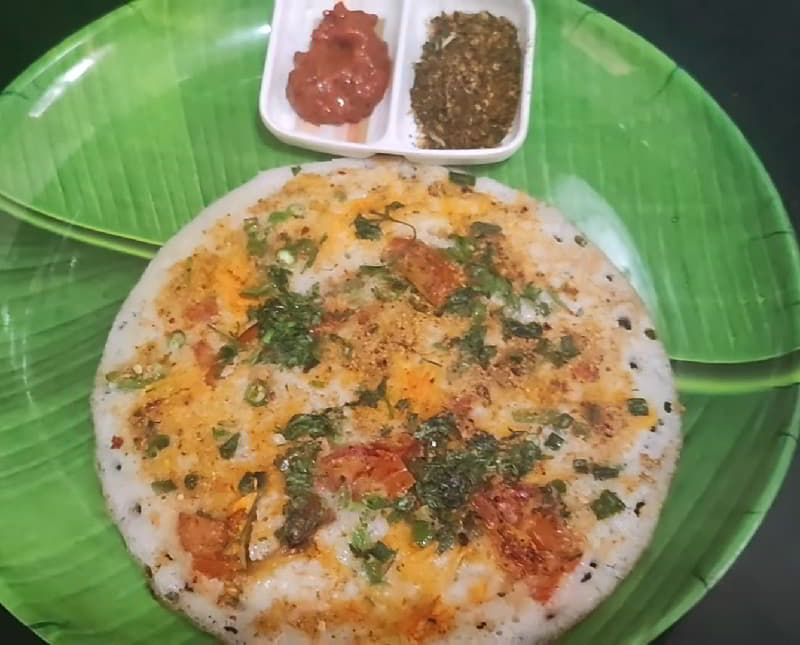
Uttapam, a widely enjoyed dish hailing from the state of Andhra Pradesh in South India, is a thick pancake crafted from fermented rice and lentil batter. This delectable treat is commonly served during breakfast or as a snack, captivating the taste buds of individuals across all age groups. The preparation of uttapam involves soaking rice and lentils overnight, followed by grinding them into a smooth consistency. The batter is then left to ferment for several hours, contributing to uttapam's soft and fluffy texture. Once the batter achieves readiness, it is skillfully spread on a hot griddle or tawa and adorned with an array of toppings such as onions, tomatoes, green chilies, and cilantro. Some delightful variations may include additional toppings like grated cheese or paneer. The uttapam is cooked until achieving a golden brown hue on one side, and then deftly flipped to cook the other side. Typically served piping hot, uttapam is complemented with condiments such as coconut chutney, tomato chutney, or sambar. Beyond its deliciousness, uttapam stands out as a healthy dish, being low in calories, rich in fiber, and brimming with essential nutrients. Its distinct taste and versatility have cemented its status as a beloved favorite among food enthusiasts.
Ariselu

Ariselu, a beloved sweet hailing from Andhra Pradesh in South India, is a festive delicacy, often gracing special occasions like weddings. The preparation of Ariselu begins with crafting a dough, a blend of rice flour or ground-soaked rice and melted jaggery. The dough undergoes meticulous kneading and is then divided into small portions, reminiscent of the process involved in making bread like poori or chapatti. These portions are delicately flattened and then fried in ghee or oil to achieve a golden hue. The finishing touch involves pressing them into sesame seeds, poppy seeds, or gingelly seeds, adding a layer of texture and enhancing the overall flavor profile. Ariselu stands as a testament to culinary artistry, embodying the rich cultural traditions and the joyous spirit of celebrations in South India.
Pulihora
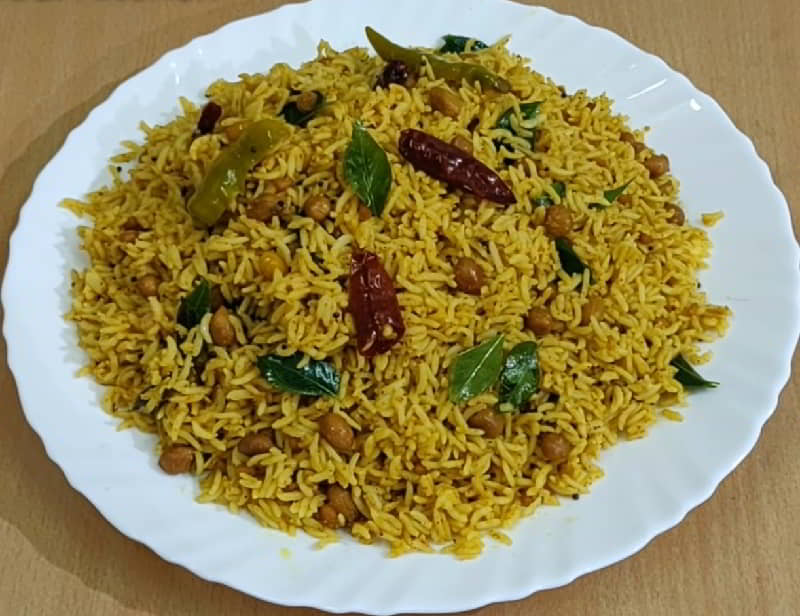
Pulihora, also recognized as tamarind rice, stands as a beloved dish in Andhra cuisine. This flavorful and tangy rice preparation is a common feature as a main course or part of festive spreads. The hallmark ingredient in Pulihora is tamarind, which imparts its distinctively sour taste. Cooked rice undergoes a harmonious blend with a paste crafted from tamarind pulp, further enriched through tempering with mustard seeds, curry leaves, dried red chilies, and an array of spices. Additionally, roasted peanuts or cashews are introduced to elevate the dish's crunch and flavor profile. Some variations of Pulihora incorporate grated coconut, sesame seeds, and turmeric for enhanced taste and color. Pulihora garners admiration for its well-balanced flavors – the tanginess from the tamarind, the nuttiness contributed by roasted peanuts, and the spiciness emanating from the tempering spices. It is commonly accompanied by a side of yogurt or raita, providing a complementary and cooling element. Pulihora's versatility allows it to shine both as a quick, satisfying meal and as a delightful accompaniment to other dishes.
Aam Papad
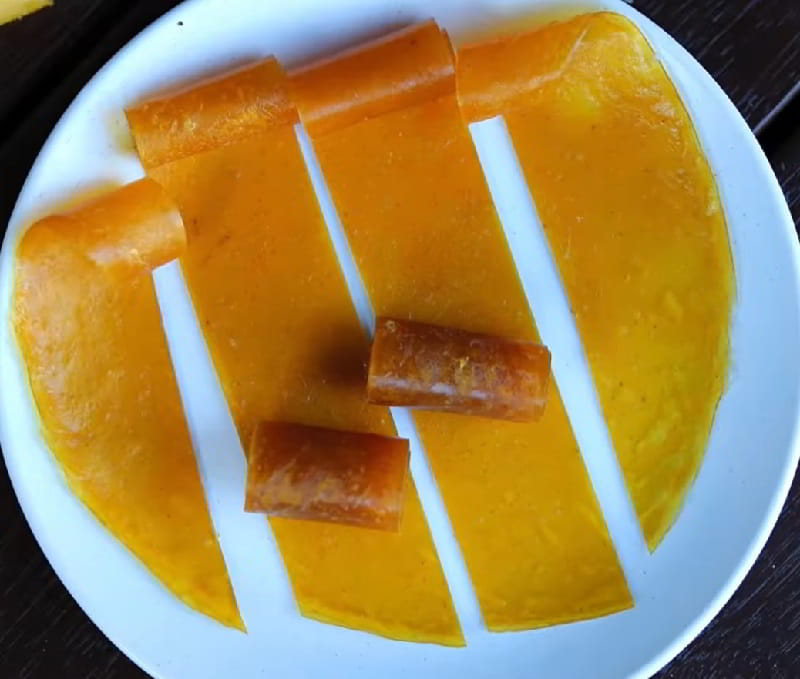
Aam Papad, a delightful Indian treat, is a fruit leather crafted from mango pulp blended with a concentrated sugar solution and then sun-dried to perfection. This traditional delicacy, primarily sweet, captures the essence of ripe mangoes in a chewy and delectable form. Available in various enticing varieties, Aam Papad is a beloved confection cherished for its rich, fruity flavor and distinct texture.
The art of making Aam Papad involves a meticulous process of sun-drying, creating a condensed, shelf-stable delicacy that can be preserved for months. This preservation method makes Aam Papad particularly popular during the off-season of mangoes when the fresh fruit may not be readily available. The sweet indulgence serves as a flavorful reminder of the mango's peak season, offering a burst of tropical goodness even when fresh mangoes are not in abundance.
Whether enjoyed on its own or as a playful addition to desserts, Aam Papad encapsulates the essence of India's love affair with mangoes. Its enduring popularity lies not only in its delightful taste but also in its ability to bring the luscious flavor of mangoes to enthusiasts throughout the year.
Pesarattu
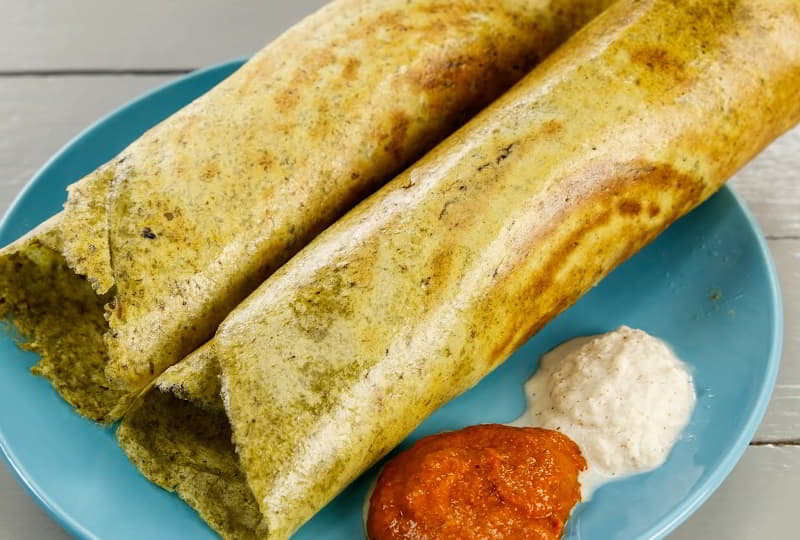
Pesarattu, a renowned and traditional dish originating from the state of Andhra Pradesh in South India, is a distinctive type of crepe fashioned from a batter of green gram dal (moong dal) and rice, meticulously ground to a smooth consistency. In the preparation of pesarattu, the batter is expertly spread on a hot griddle or tawa, where it is cooked to achieve a crispy and golden brown perfection. Typically, it is served alongside an array of accompaniments, including upma, ginger chutney, coconut chutney, or allam pachadi (a spicy ginger pickle). Beyond its deliciousness, pesarattu boasts nutritional benefits as it is crafted from green gram dal, known for being a commendable source of protein and dietary fiber. Furthermore, it maintains a low-fat and low-cholesterol profile, positioning it as a wholesome and health-conscious choice for breakfast or any other meal throughout the day. The unique taste and texture, coupled with its nutritional value, have elevated pesarattu to the status of a beloved dish among individuals of all ages in Andhra Pradesh and beyond.
Pachadi
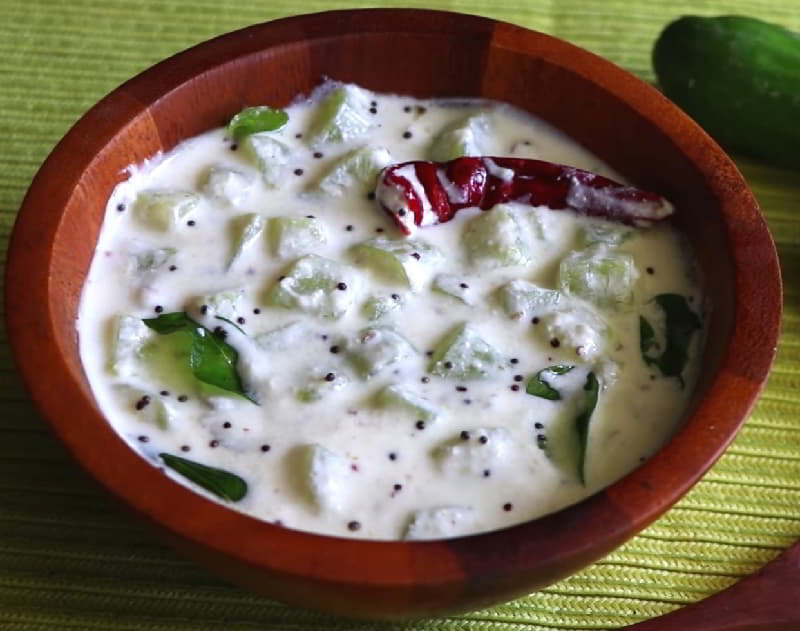
Andhra cuisine is known for its bold flavors and vibrant colors, and one of the popular dishes in this culinary tradition is Pachadi. It is a classic South Indian condiment, often likened to a fresh pickle, and serves as a delectable side dish. The term, roughly translating to a plant that has been pounded or crushed, signifies its preparation method. Comprising a medley of fresh vegetables, Pachadi is a customary accompaniment to dishes like idli, dosa, and Pesarattu. Its versatility is evident in the inclusion of various vegetables, and at times, the use of vegetable peels, such as the ridged gourd peel, known as beerapottu pachadi in Telugu. The dish is distinguished by its vibrant flavors, blending the freshness of vegetables with the creaminess of yogurt, creating a delightful side that elevates the dining experience in South Indian cuisine.
Ulava Charu
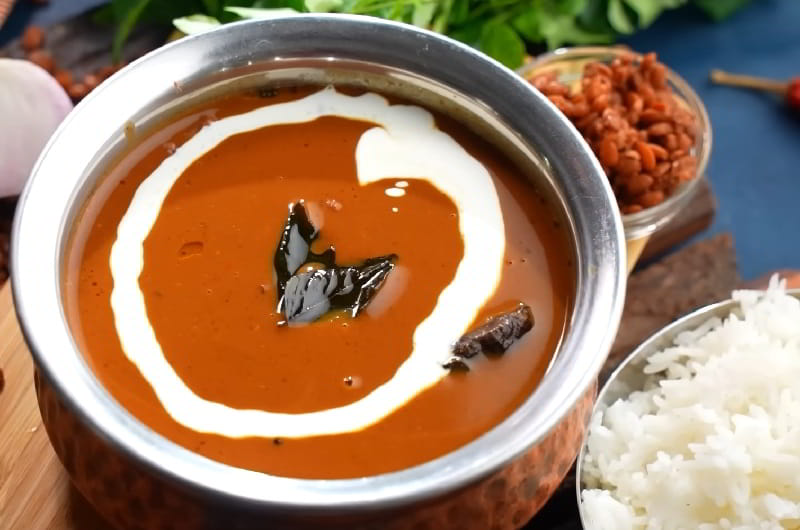
Ulava Charu, a flavorful rasam hailing from Andhra Pradesh, India, is particularly renowned in the Guntur and Krishna districts. This traditional South Indian soup-like dish is crafted with horse gram, locally known as "ulava" in Telugu. The preparation involves boiling horse gram in water with salt, followed by straining the legume from the soup before serving. This distinctive rasam stands as a local delicacy, appreciated for its unique taste and regional significance. Notably, Ulava Charu's popularity is also attributed to its labor-intensive preparation method, highlighting the dedication and effort invested in creating this cherished dish in Andhra Pradesh. The inclusion of horse gram adds a distinctive touch, making Ulava Charu a sought-after culinary delight in the vibrant tapestry of South Indian cuisine.
Kakinada Kaaja

Kakinada Kaja is a delectable sweet that originates from Kakinada, a city in the East Godavari district of Andhra Pradesh, India. It is a popular and traditional dessert known for its unique taste and flaky texture. Kakinada Kaja is made primarily from all-purpose flour (maida), ghee (clarified butter), and sugar. The preparation involves creating a dough by combining all-purpose flour and ghee. This dough is then rolled out into thin layers, and a mixture of sugar and ghee is spread between these layers. The layered dough is then rolled and cut into small, rectangular shapes. These pieces are deep-fried until they achieve a golden brown color, resulting in a crispy and flaky texture.
Poornalu
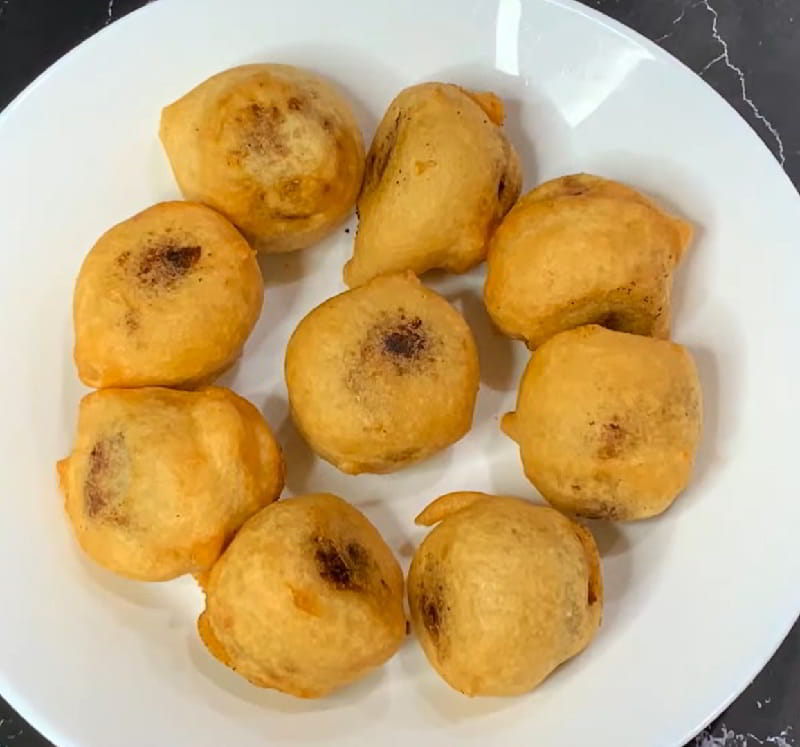
Poornalu, a cherished sweet originating from the vibrant Andhra cuisine in India, embodies the essence of traditional culinary craftsmanship. These dumplings, crafted from rice flour, encapsulate a delightful filling consisting of jaggery-infused dal paste and an array of dry fruits. The preparation of Poornalu adheres to time-honored techniques shared across South Indian cuisines. The Poornam Boorelu variant involves crafting a batter from rice and urad dal, which is then skillfully packed with a mixture of shredded dry fruits and channa dal known as poornam. The resulting dumplings are meticulously deep-fried until they attain a captivating golden brown hue. Best enjoyed when served hot and complemented with ghee, Poornalu stands as a testament to the rich culinary heritage and the perfect amalgamation of flavors found in Andhra's sweet traditions.
Sweet Shells
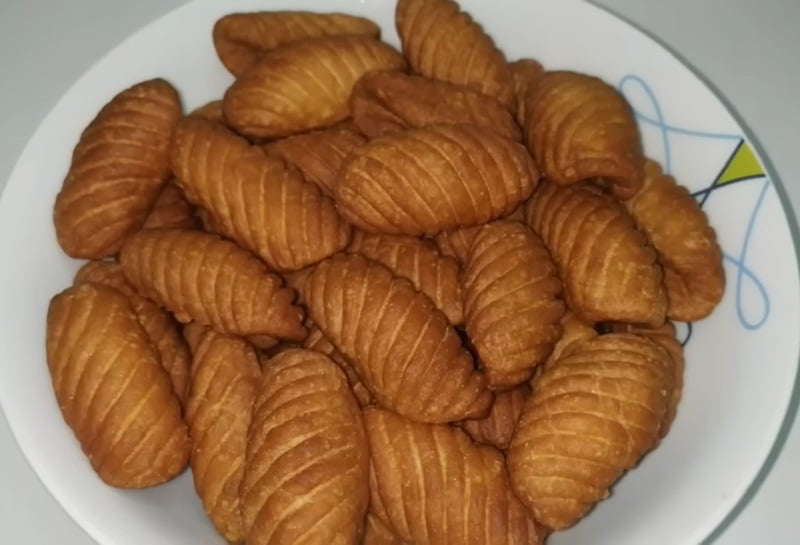
Sweet Shells, also recognized as Pootharekulu, represent a quintessential Indian sweet originating from the culinary landscape of Andhra Pradesh, India. This delicacy is crafted from a mixture of plain flour (maida) combined with either water or milk. The dough undergoes a meticulous process where it is shaped into small rounds, flattened, and rolled using a special tool, resulting in shells resembling the distinctive form of cowrie shells or gavvalu. Following this, the shells are delicately fried in either oil or ghee, achieving a crisp texture. The final touch involves immersing these delectable shells in a syrup made from sugar or jaggery, adding a sweet and flavorful essence to the unique Pootharekulu, making it a cherished and iconic treat in Andhra Pradesh's rich sweet repertoire.
Pachi Pulusu
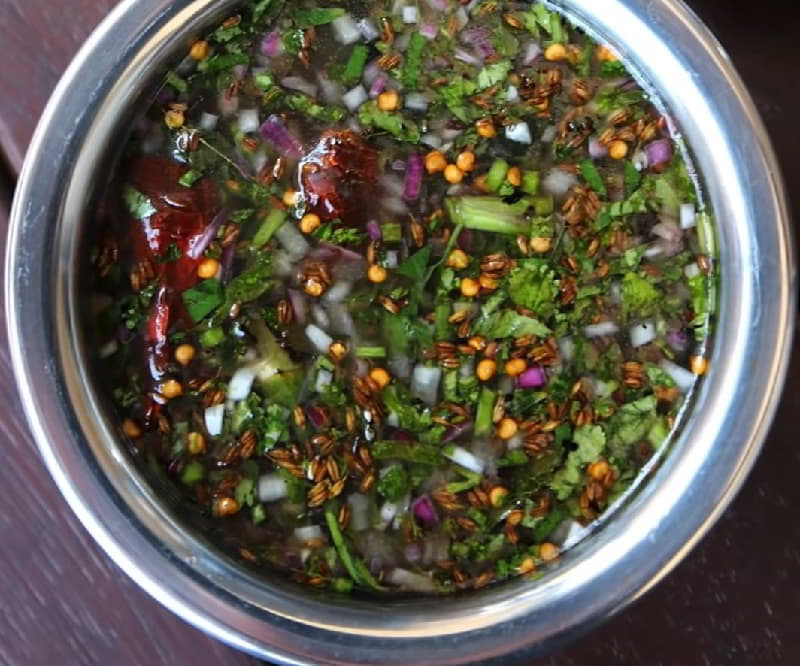
Pachi Pulusu stands out as the chilled rendition of the traditionally hot tamarind soup, known as chāru, prevalent in the culinary landscape of Andhra Pradesh and Telangana, especially during the summer season. Diverging from the standard pulusu, this variant is characterized by its heightened spiciness, lighter consistency, and increased water content. The dish is crafted using tamarind infused with elements like onions, chillies, and jaggery, offering a dynamic interplay of flavors. Additional seasonings, including coriander, curry leaves, or garlic, contribute to its distinctive taste profile. During the mango-abundant summer season, a delightful twist is introduced by substituting tamarind with stewed raw mango, adding a refreshing and tangy dimension to the Pachi Pulusu. This dish not only serves as a culinary respite during the sweltering heat but also showcases the regional adaptability and creativity in Andhra and Telangana cuisine.
Sunnundallu

Sunnundallu is a traditional sweet dish that hails from the southern state of Andhra Pradesh in India. It is a popular delicacy made from roasted and powdered Urad dal, also known as black gram. The process of making Sunnundallu begins with roasting the Urad dal until it turns golden brown, which gives it a distinct nutty flavor. Once roasted, the dal is ground into a fine powder. This powder is then mixed with jaggery or sugar and shaped into small, round balls or laddus. These laddus are not only delicious but also nutritious as Urad dal is rich in protein and fiber. Sunnundallu is often enjoyed as a snack or served as prasad (offering) in temples during festivals and special occasions. The sweetness of the jaggery or sugar perfectly complements the earthiness of the Urad dal, creating a delightful balance of flavors. The texture of Sunnundallu is soft and crumbly, making it a delight to savor. Sunnundallu is not only a treat for the taste buds but also holds cultural significance in Andhra Pradesh. It is a dish that brings people together, symbolizing love, warmth, and celebration.
Palathalikalu
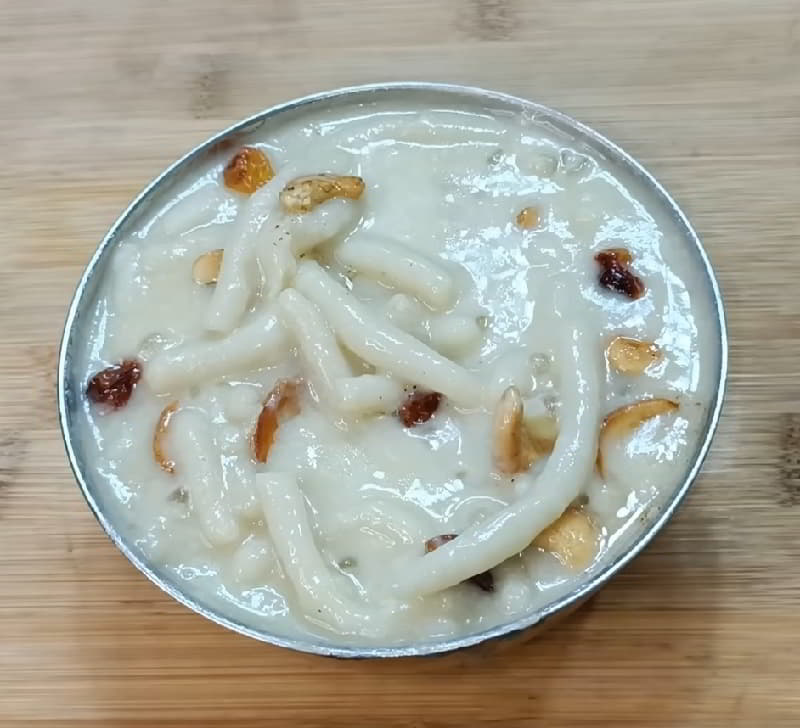
Palathalikalu, a revered dish in Andhra Pradesh, stands as a cherished tradition in the hearts of its people. Crafted from a combination of clarified butter, rice flour, and sago, and the ingredients are skillfully transformed into a dough. This dough is then delicately cooked or steamed in milk, yielding a delightful culinary creation. The final touch involves an artful garnish of raisins, cardamom powder, and cashews, enhancing the dish with a medley of textures and flavors. Beyond its culinary significance, Palathalikalu represents a cultural connection, embodying the culinary heritage of Andhra Pradesh. This traditional dish, with its meticulous preparation and rich flavors, continues to be a symbol of familial and communal celebrations, marking special moments with a taste that resonates with the region's culinary prowess.
Chikkolee

Chikkolee, a flavorful wheat-based delicacy, is a culinary specialty found in southern Andhra Pradesh and certain regions of Maharashtra. The preparation method resembles that of roti (chapathi), where the wheat base is cut into pieces and enhanced with a blend of aromatic spices. Originating from the culinary traditions of the Rangrez and Bhavasara Kshatriya communities, Chikkolee is a traditional pudding with a semi-liquid consistency, incorporating crushed wheat. This delectable dish occasionally features the addition of meat pieces, adding a savory element to the overall flavor profile. Beyond its traditional presentation, Chikkolee has found versatility and can also be savored as a delightful snack. Its rich heritage and regional variations make it a noteworthy culinary delight, offering a unique gastronomic experience that reflects the diverse and vibrant food culture of the area.
Hibiscus Leaves Pickle
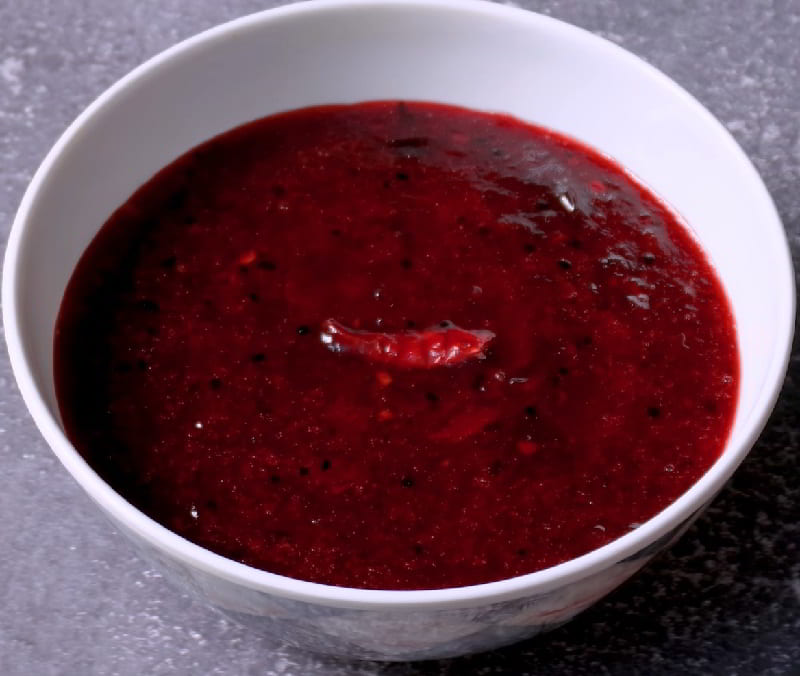
Gongura pachadi, commonly known as Hibiscus leaves pickle, stands out as a popular dish in Andhra cuisine. Crafted from the tangy leaves of the hibiscus plant, this pickle brings a unique flavor to the table. The preparation begins by washing and finely chopping the hibiscus leaves, which are then blended with an array of spices including mustard seeds, fenugreek seeds, red chili powder, turmeric powder, and salt. The amalgamation is sautéed in oil until the leaves achieve a soft and wilted texture. To heighten the sourness, tamarind pulp is introduced to the mix. Subsequently, the pickle is left to cool and mature for a few days, allowing the flavors to harmonize. Typically served as a condiment accompanying rice or roti, this pickle imparts a burst of tangy and spicy flavor to any meal. Its preservation properties ensure an extended shelf life, making it a practical choice for storage. Gongura pachadi is cherished for its distinctive taste and versatility, with its tangy and spicy notes perfectly complementing the mildness of rice or roti. A must-try for those eager to delve into the diverse and delectable cuisine of Andhra Pradesh.
Vankai Curry
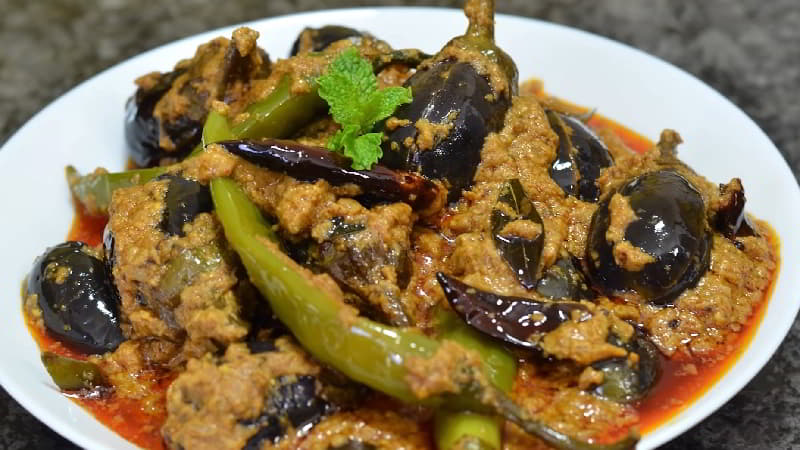
Andhra cuisine is renowned for its robust flavors and spicy offerings, and among its popular dishes is the Vankai (Brinjal) Curry also known as Gutti Vankaya. This dish showcases small brinjals (eggplants) stuffed with a spicy and aromatic masala mixture. The preparation involves making a paste from a blend of roasted spices, typically including coconut, peanuts, sesame seeds, and various spices such as red chili powder, coriander, and cumin. To create Gutti Vankaya, the brinjals are slit or partially sliced, and then the prepared masala paste is generously stuffed into each one. The stuffed brinjals are then gently cooked in a pan with jaggery, tamarind extract, and additional spices until they become tender. The slow cooking process allows the brinjals to absorb the flavors of the masala, resulting in a rich and satisfying curry. Gutti Vankaya is often served with steamed rice or Indian bread, making it a delightful and well-loved dish in Andhra Pradesh cuisine.
Puri
-1705500873.jpg)
Puri, is a deep-fried bread crafted from wheat flour, salt, and water. Paired with an array of side dishes, this culinary delight undergoes a meticulous process, commencing with the kneading of the dough to attain a soft and pliable consistency. The dough is then skillfully rolled into small, circular shapes before being deep-fried to a golden brown, resulting in a light and crispy bread capable of absorbing the flavors of its accompanying dishes. Often accompanied by a spicy potato curry, known as aloo masala, Puri becomes a satisfying and flavorful meal. Additional popular accompaniments encompass dal, chutney, and pickles. The amalgamation of the soft and fluffy puris with these flavorful and spicy side dishes creates a delectable experience for the taste buds. Versatile and cherished, Puri finds its place on breakfast, lunch, or dinner tables.
Chapati
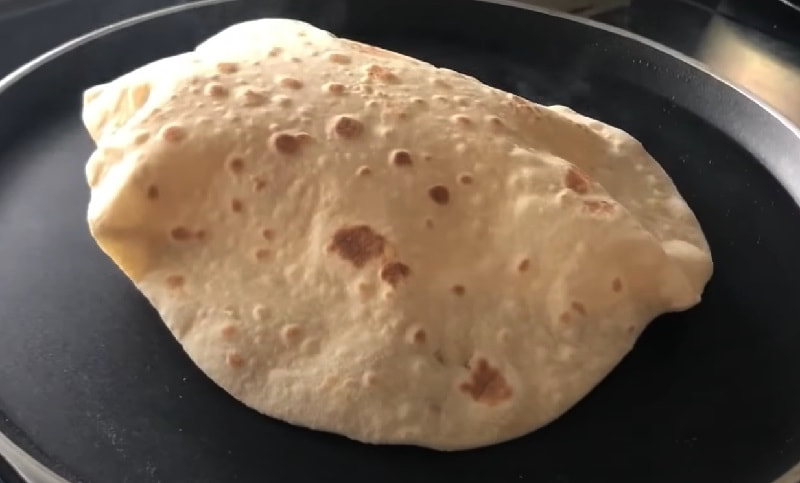
Chapati, also known as roti, is a traditional Indian flatbread widely consumed in Andhra cuisine. Made from wheat flour, this dish is a staple in most households and is enjoyed with a variety of curries and side dishes. The process of making chapati involves kneading the dough with water and salt, then rolling it out into thin circular shapes, and finally cooking it on a tawa, a flat griddle. Andhra-style chapati differs from its counterparts in other regions due to its unique flavors and accompaniments. The dough is usually flavored with ingredients like cumin seeds, ajwain, or even chopped coriander leaves, which add a distinct taste to the chapati. It is often served hot and brushed with ghee or butter for added richness. Chapati is a versatile dish that can be enjoyed for breakfast, lunch, or dinner. It pairs well with a wide range of curries such as dal, paneer, or chicken. In Andhra cuisine, it is commonly served with spicy and tangy gravies like tomato pappu or gutti vankaya kura. Overall, Andhra-style chapati is a delicious and wholesome dish that showcases the culinary diversity of Andhra cuisine. Its simplicity, versatility, and ability to complement various curries make it a favorite among people of all ages.
Benne Dose
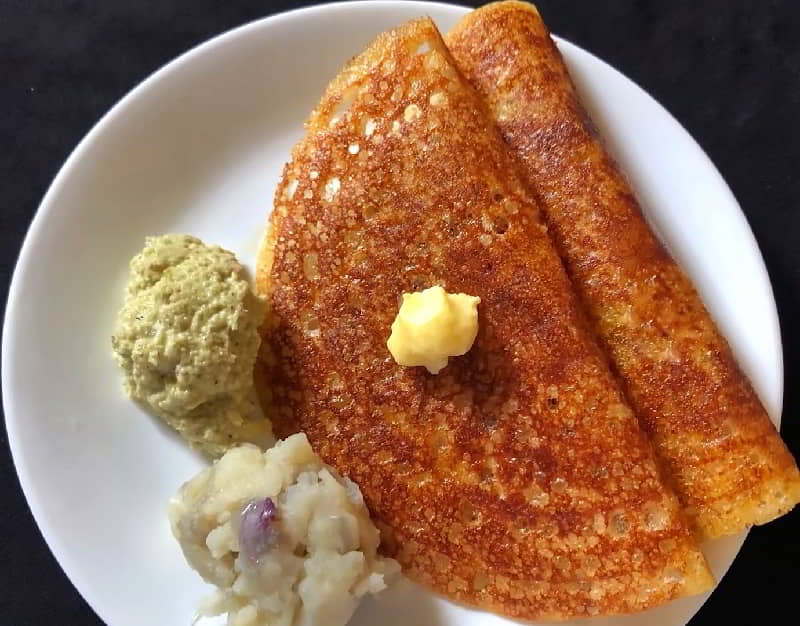
Benne Dose is a variation of the traditional dosa, which is a fermented rice and lentil crepe. Benne Dose gets its name from the word "benne," which means butter in the local language. The dish is made using a batter prepared with rice and urad dal (split black gram), which is fermented overnight to develop a tangy flavor. The batter is then spread thinly on a hot griddle and cooked until crispy and golden brown. What sets Benne Dose apart from regular dosas is the generous amount of butter used while cooking, which gives it a rich and indulgent taste. Benne Dose is typically served with a variety of chutneys and sambar, a lentil-based vegetable stew. The combination of the crispy dosa and the flavorful accompaniments makes it a popular breakfast or brunch option in Andhra Pradesh. The dish is loved for its unique texture, with a slightly crispy exterior and a soft interior. The addition of butter enhances the taste and adds a smooth and creamy texture to the dosa. Benne Dose is a must-try for anyone looking to experience the flavors of Andhra cuisine.
Neer Dosa
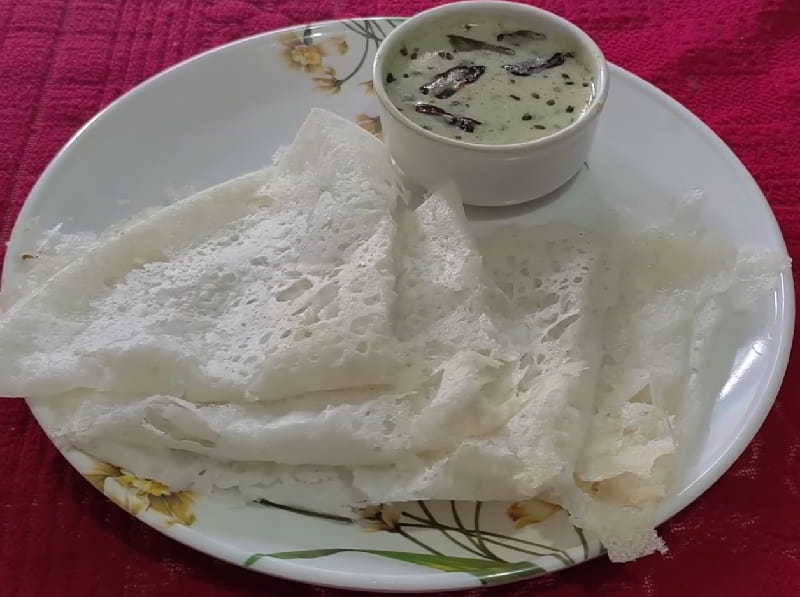
Neer Dosa is a celebrated pancake, its name "neer" translating to "water" in the local language, aptly describing its unique consistency. Notably, neer dosa distinguishes itself with a straightforward preparation method that eliminates the need for fermentation. The process involves soaking rice for a minimum of 2 hours, followed by a thorough wash and grinding to achieve an exceptionally fine batter, with water added as needed for desired thickness. The addition of salt enhances the taste of the batter. This distinctive batter is then used to prepare the dosa. Unlike its counterparts, neer dosa stands out for its simplicity and absence of fermentation. Typically served with accompaniments like coconut chutney, sambar, saagu, and various non-vegetarian curries such as fish, chicken, egg curry, and mutton, neer dosa embodies a delightful blend of simplicity and flavor in Andhra culinary traditions.






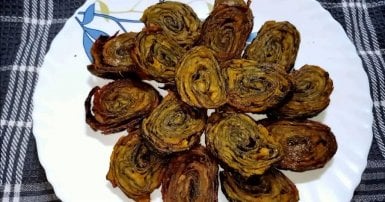
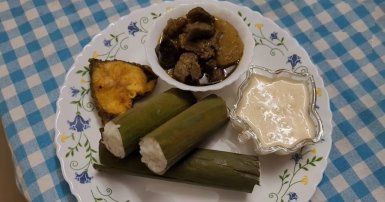
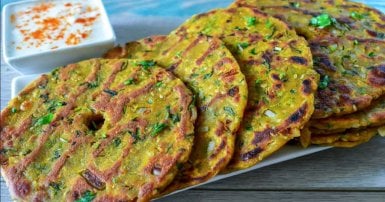
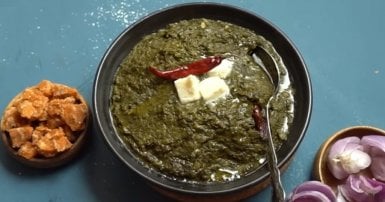
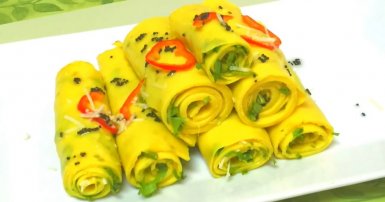
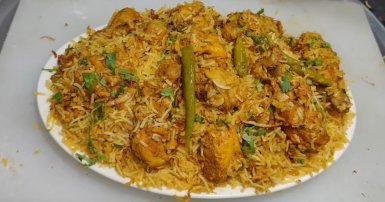

-1709813013.jpg)


